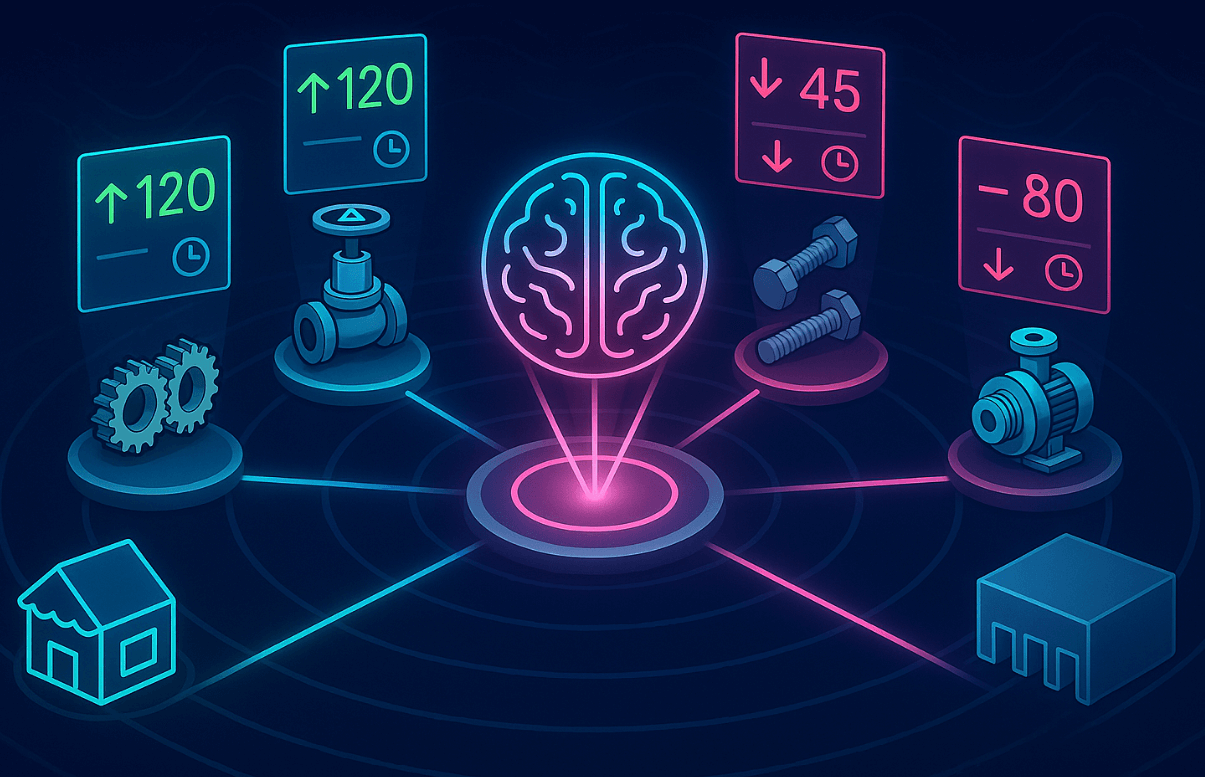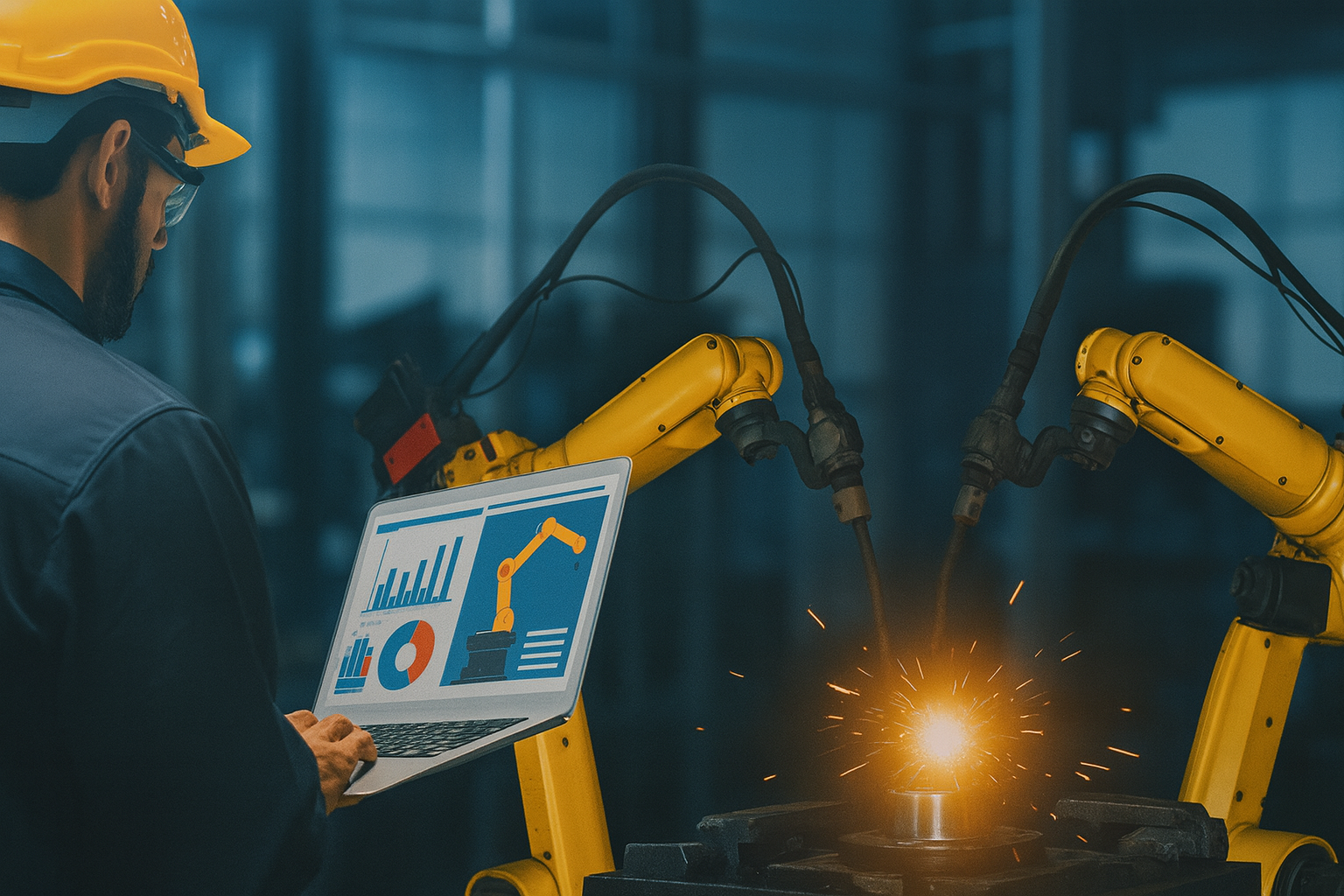When Static Pricing Breaks in a Volatile Market
It usually happens overnight.
A steel supplier closes a big order on Monday only to wake up Tuesday to news that global steel prices jumped 20%. By the time the ink dries, the deal that felt like a win has already turned into a loss. The margin is gone before the first shipment leaves the warehouse.
That’s the reality of industrial B2B pricing today. Resin, copper, chemicals, and composites—the inputs manufacturers rely on—shift with demand and move faster than most teams can keep up. A spreadsheet updated once a quarter, or even once a month, just can’t keep pace. By the time the new numbers trickle down to the e-commerce portal, sales team, and ERP, half a dozen quotes have already gone out at the wrong price.
Buyers and retailers feel it too. One week they’re told a resin part costs $12; the next week the portal still shows $12, but the quote from sales says $14. Nobody likes surprises, least of all procurement officers managing multi-million-dollar budgets. To them, mismatched or outdated prices don’t just look sloppy—they feel like a breach of trust.
Static pricing is slow. The market is fast. And when those two collide, it’s not just margins that suffer. It’s relationships.
That’s why industrial suppliers are beginning to lean on AI-driven pricing—not as a futuristic experiment, but as survival. By tying BigCommerce storefronts directly to real-time cost data, AI engines adjust prices the moment markets move. The buyer sees accurate, transparent quotes in their portal. The supplier protects margin without scrambling to fix spreadsheets. Trust stays intact, and business keeps moving.
The promise isn’t complicated: never miss a market shift again. The path to get there is what we’ll break down in this guide.
The Harsh Reality of Industrial Pricing Volatility
For anyone outside the industry, it’s hard to appreciate just how wild raw material markets can be. One month, resin prices ease off, and everything feels stable. The next, a geopolitical event or supply chain disruption sends costs soaring. Steel, copper, aluminum, chemicals—each has its own rhythm, but the common thread is unpredictability.
On paper, volatility looks like a chart with jagged peaks and valleys. In reality, it plays out in frantic calls between sales, finance, and operations. A quote sent out last week suddenly puts the supplier underwater. A buyer who thought they’d locked in fair terms is now staring at a “revised” offer. Trust takes the hit long before the invoice arrives.
Margins don’t erode slowly, they vanish overnight. A two-point shift in resin costs across thousands of units can wipe out profitability on an entire contract. And because industrial orders aren’t small—they often stretch into six or seven figures—one bad quote can offset months of careful planning.
B2B buyers see the instability too. Procurement teams budget around supplier quotes, build schedules based on expected costs, and answer to executives who don’t tolerate surprises. When a supplier sends one number on Monday and another on Friday, it doesn’t just create paperwork. It makes the supplier look unreliable.
The truth is simple: volatility isn’t the exception anymore. It’s the norm. And trying to tame it with quarterly price reviews or static spreadsheets is like steering a tanker ship with a rowboat paddle. You can move, but not fast enough to matter.
That’s the pressure point where suppliers either adapt or bleed margin.
Why Spreadsheets and Manual Updates Don’t Work Anymore
For years, spreadsheets were the backbone of industrial pricing. Someone in finance built models that tracked supplier costs, someone else updated surcharges, and every few weeks the team would push out a “latest version” of the price list. It wasn’t elegant, but it worked — at least when markets moved slower.
Today, it doesn’t work at all.
The lag is obvious. By the time a new spreadsheet makes its way from finance to sales to e-commerce, the market has already shifted again. A copper surcharge that looked fine on Monday is out of date by Wednesday. Sales reps are quoting one number, the BigCommerce portal is showing another, and ERP is holding a third. Buyers end up caught in the middle, unsure which price to trust.
Errors creep in too. A missed decimal, an outdated row, a forgotten SKU buried in a list of thousands—it only takes one mistake to misprice a critical part. That error doesn’t just cause internal headaches; it lands on a buyer’s desk, turning into a dispute, a delay, or a lost order.
The ripple effects are exhausting. Sales teams lose credibility because they’re constantly backpedaling. Finance spends nights reconciling mismatches. Operations hesitates to schedule production because no one is sure which price is “real.” And the buyer, who just wanted a straight answer, starts questioning whether the supplier is stable enough to handle their needs.
Manual updates don’t just slow you down. They create chaos. They make your company look reactive in a market where speed and consistency are everything. And the longer you lean on them, the more fragile your margins—and your relationships—become.
What Buyers and Customers Actually Expect in Pricing Transparency
Procurement teams working in metals, plastics, or chemicals know the markets swing. They read the same industry indexes suppliers do. What frustrates them isn’t that prices move—it’s when suppliers hide behind delays or deliver conflicting numbers.
Picture a procurement officer who budgeted around a $14 resin component. They log into the portal on Wednesday, and it still shows $14. By Friday, they get a revised quote from sales at $16. Same part. Same supplier. Two different answers. From their perspective, it feels like a bait-and-switch, even if it’s just bad timing.
What buyers want is simple: consistency. If prices rise, they want to see that reflected across every touchpoint at the same time—in the portal, in quotes, and in their ERP feeds. No hidden surprises. No reissued quotes that stall projects.
They also expect fairness. If a market dip makes raw materials cheaper, buyers don’t want to find out weeks later that they’ve been paying inflated prices. The supplier who adjusts pricing transparently when costs fall earns more trust than the one who clings to old numbers.
And trust is the currency here. Industrial buyers don’t switch suppliers over a few cents per unit—they switch when they stop believing the supplier is looking out for them. Transparency in pricing signals reliability. It tells buyers, “We’re tracking the market right alongside you, and you’ll never be caught off guard.”
That’s the kind of reassurance that keeps contracts safe, even in volatile times.
The Case for AI-Powered Pricing Services in Industrial B2B
The problem with volatility isn’t knowing it exists—it’s reacting fast enough to keep up. By the time a pricing committee meets, by the time a spreadsheet circulates, by the time changes make it into BigCommerce, the market has already shifted again. That lag is what eats margins and frays relationships.
This is where AI earns its place. Not as a buzzword, but as a tool that does one thing better than humans ever can: process constant change at speed.
An AI pricing engine isn’t guessing. It pulls in live feeds from commodity indexes, supplier costs, and even historical patterns from your own ERP. It sees that steel ticked up three percent overnight, or resin dipped slightly last week, and it adjusts the relevant SKUs before a buyer even hits “add to cart.” The logic isn’t arbitrary—it’s based on the rules you set: protect margins at a certain floor, apply surcharges fairly, and align with contract escalators.
What AI does is remove the gap between market movement and your response. Instead of reacting weeks late with apologies and revised quotes, your portal stays in sync with reality. Buyers see accurate prices when they log in, sales reps quote the same numbers, and finance knows margins are being defended in real time.
It doesn’t replace pricing strategy—it enforces it. Think of it as a system that makes sure the rules you already rely on actually get applied, every hour of every day, without human delay.
In a world where buyers are tired of surprises and volatility isn’t slowing down, that kind of responsiveness isn’t optional. It’s survival.
How AI Pricing Handles Vast Amounts of Data on BigCommerce
For most industrial teams, “AI pricing” sounds abstract—almost like black magic. But when you strip it down, it’s straightforward: data goes in, logic is applied, and prices come out the other side. The power isn’t a mystery, it’s speed.
Here’s what that looks like inside BigCommerce.
The system pulls data from multiple sources. Commodity indexes show where steel, copper, resin, or chemicals are trending. Supplier feeds reflect the costs you’re actually paying. ERP adds context—contract terms, historical purchase volumes, and agreed surcharges. That stream of inputs forms the baseline.
On top of that, you layer your business rules. Maybe you need to maintain a 12% margin minimum on steel components or automatically pass along a portion of resin fluctuations to buyers with cost-plus contracts. The AI engine doesn’t invent new logic. It enforces the rules you define, but it does so in real time, across thousands of SKUs, without waiting for a manual update.
Once the logic is applied, BigCommerce becomes the delivery point. The catalog updates instantly. A buyer logging in at 9:00 a.m. sees the same accurate number your sales team quotes at 9:05. No delays, no contradictions, no awkward phone calls later in the week to “correct” a price.
From the buyer’s perspective, the experience feels seamless. They aren’t aware of indexes or algorithms running in the background. All they see is pricing that makes sense, stays consistent, and adjusts as the B2B market moves. That kind of alignment turns a storefront from just a catalog into a living reflection of the real market.
For suppliers, the benefit is just as clear: no more late-night spreadsheet updates, no more manual overrides, and no more racing to fix quotes after the fact. AI keeps the storefront in lockstep with reality so teams can focus on selling and serving—not patching.
ERP and Contract Integration — Updating Prices Without Breaking Trust
In industrial supply, not every buyer walks through the door the same way. Some grab what they need off the spot market, order by order, no strings attached. Others sign long contracts built on negotiations, escalation clauses, and agreements that were pored over by lawyers on both sides. Treat those two groups the same, and you’re not just making a pricing mistake—you’re lighting a fuse.
That’s why ERP matters.
The ERP already knows the fine print. It knows which customers are tied to contracts, which ones float with the market, and how credit terms shape their orders. AI pricing, if it’s worth anything, has to respect those rules. If resin spikes 8% overnight, the system can’t just spray the increase across every SKU. For contract buyers, it needs to honor the escalation clause to the letter. For spot-market buyers, it can move quickly, adjusting to current indexes without breaking a deal.
This is trust. A contract buyer expects stability, and if your portal suddenly overrides negotiated terms, you’re not just creating a dispute—you’re tearing at the relationship itself. ERP integration makes sure the storefront remembers what was already signed and sealed.
It also leaves a trail. Every adjustment the AI makes gets logged, tracked, and defended. So when procurement pushes back or compliance needs proof, you don’t have to dig through inboxes and half-broken spreadsheets. The evidence is already in the system.
Buyers feel the difference immediately. They log in, and the prices make sense, aligned with their agreements, updated in real time, with no back-and-forth needed. Suppliers feel it too. Margins are protected, contracts are safe, and no one has to gamble a relationship just to keep pace with the market.
That’s the real test of AI pricing. Not just chasing indexes. Not just updating numbers. But doing it in a way that holds the business together—fair, clear, and built on trust.
Business Impact — From Firefighting to Confidence
Before AI pricing, every market swing felt like the building caught fire. Finance would be hunched over spreadsheets, trying to patch holes faster than the numbers blew out. Sales was on the phone, half-embarrassed, telling buyers, “Yeah, that quote I gave you yesterday? It’s already off.” Operations would hit pause because no one was sure if production was running on the right price. The whole place lived in reaction mode—always a step late, always chasing.
Buyers could feel it too. One number on the site, another in a quote, and sometimes a third when the invoice landed. Even if you explained it— “steel jumped twelve percent, nothing we could do”—the trust was already cracked. From their side, it didn’t look like market volatility. It looked like you didn’t know what you were doing.
Now picture the same company with AI pricing wired into BigCommerce. Prices move with the market everywhere at the same time—catalog, quotes, ERP, invoices. Finance isn’t sweating bullets. They can actually see margins holding. Sales isn’t apologizing. They quote once and know it will stand tomorrow. Ops isn’t stuck second-guessing. Orders run, the math behind them solid.
And the strangest part? Things get quiet. No alarms, no scramble. Just business moving at a steady pace, in sync with the market instead of tripping over it. Buyers notice, too. They stop waiting for the “surprise” correction. They start to believe what they see, and that belief—that confidence—sticks. In B2B, that kind of loyalty is worth more than squeezing another point of margin.
AI pricing doesn’t just clean up numbers. It changes the pulse of the place. From panicked to steady. From firefighting to focus. And in markets that never sit still, that difference is the line between bleeding out and actually growing.
Overcoming Common Challenges in AI Pricing Adoption
Every supplier likes the idea of smarter pricing, but when it comes time to implement, doubts creep in. Some of them are technical, others cultural. Ignoring them is what makes AI feel like a buzzword instead of a solution. Addressing them head-on is how adoption sticks.
The first fear is the “black box.” Nobody in finance or sales wants to hand over pricing power to an algorithm they can’t explain. That fear is valid—if AI looks like it’s pulling numbers from nowhere, trust collapses internally before buyers ever see a price. The answer is transparency. The best AI pricing engines show the inputs and rules behind every change: the steel index increased 3%, the applied margin floor is at 12%, and the updated SKU group is accordingly. When people can trace the “why,” they stop resisting the “how.”
The second hurdle is cultural. Sales teams are used to having the final word on pricing. They’ve built relationships on discretion, and they worry automation will take that away. The truth is, AI doesn’t replace sales judgment—it protects it. Instead of wasting time correcting outdated quotes, reps can focus on negotiations, volume commitments, and contract renewals. AI handles the market math; sales keeps the human touch.
Then there’s the technical lift. Pulling data from commodity indexes, syncing ERP, updating BigCommerce—it sounds like a monster project. In reality, it works best when phased. Start with one product line. Prove that pricing can track live costs without chaos. Once everyone sees the system holds, roll it out wider. Small wins build confidence, and confidence builds momentum.
And then there’s the buyer’s side of the story. A lot of suppliers assume customers will resist dynamic pricing, push back hard, and maybe even see it as unfair. But more often than not, the opposite happens. Buyers already know markets move—they live it every day. What they can’t stand is being blindsided. Seeing prices adjust in real time, in a way that makes sense, feels fairer than getting hit with a correction after the fact. That kind of consistency ends up building more trust than any set of frozen numbers ever could.
Adopting AI pricing isn’t about flipping a switch and declaring victory. It’s slower and more human than that. It’s about getting your team comfortable, showing buyers the system works in their favor, and letting that trust grow. Over time, people stop seeing it as a gamble. They see it for what it really is: a safeguard—a way to keep business steady even when the market isn’t.
Competitive Advantage of AI Pricing in Volatile Markets
Most industrial suppliers live in reaction mode. They wait for market reports, patch spreadsheets, and hope their sales team can smooth things over when prices change mid-quote. Buyers see it, and they file the experience away: “That supplier is always scrambling.” It doesn’t matter how good the product is if the buying process feels unstable.
Now compare that to a supplier running AI-driven pricing on BigCommerce. The numbers in the portal always line up with reality. Quotes don’t need walk-backs. Contracts aren’t jeopardized by mismatched figures. When steel jumps 8% overnight, the buyer sees the adjustment reflected the same morning across every touchpoint. Instead of confusion, there’s clarity.
That difference becomes a brand. While competitors are still explaining delays or apologizing for “revised” quotes, you’re proving in real time that you can manage volatility without drama. Procurement officers remember that. In renewal cycles, they don’t just weigh cost per unit — they weigh confidence. Who will keep their projects on schedule? Who will prevent surprises that ripple all the way up to the CFO?
AI pricing also frees your team to compete where it matters. Sales doesn’t spend hours patching mistakes; they focus on growth. Finance doesn’t sit in endless “price update” meetings; they refine strategy. Operations doesn’t stall production waiting for corrections; they build and ship. Efficiency itself becomes a competitive weapon, giving you an edge over competition still stuck in spreadsheets.
In volatile markets, price isn’t just a number — it’s a signal of competence. Suppliers who can’t keep up look shaky. Suppliers who move in step with the market look strong. And strength is what wins contracts that last.
AI Pricing Toolkit for Industrial B2B on BigCommerce
Protect margins. Build trust. Keep pace with volatile markets.
Pricing Stability Checklist
Before going live with AI-driven pricing, make sure these are locked in.
☐Live data feeds connected (commodity indexes, supplier costs, ERP)
☐Margin floors defined per category (ex: steel 12%, resin 10%)
☐Escalation rules set for contracts (spot vs long-term)
☐Real-time sync tested across BigCommerce, ERP, and sales quoting tools
☐Buyer portal shows consistent prices everywhere (no “site vs. quote” mismatch)
☐Logging enabled (audit trail for every price update)
How to use: Run this like a safety inspection. If any box stays unchecked, your portal risks showing “ghost prices” that destroy trust.
Price Integrity Scorecard
Measure if your pricing engine is doing its job.
| Metric | Target | Warning | Red Flag |
| Catalog vs. Quote Consistency | 100% | 95–99% | <95% |
| Margin Protection | ≥ defined floor | 1–2 pts below | >2 pts below |
| Update Speed | <1h from market change | Same day | >24h |
| Buyer Disputes | <2 / quarter | 3–5 | 6+ |
| Contract Compliance | 100% | Any miss | Repeat misses |
How to use: Review monthly with finance + sales. If you see red flags, buyers already feel the cracks.
Buyer Transparency Table
What buyers should see in their portal — and why it matters.
| Visible to Buyer | Why It Matters | Trust Signal |
| Current live price | Matches today’s market | No hidden surprises |
| Contract price rules | Escalators / floors respected | “They honor our terms” |
| Recent change log | Shows last update date | Proves fairness |
| Spot vs. contract clarity | Different pricing types shown clearly | Removes confusion |
How to use: Treat this as your UX spec. If a buyer can’t see these four things, they’ll assume you’re hiding something.
The Future of Pricing Is Adaptive
Volatility isn’t going away. Steel will spike again. Resin will dip and rebound. Chemicals will swing on supply shocks you can’t predict. The question isn’t if costs will move—it’s whether your pricing can move with them.
Static systems can’t. Spreadsheets can’t. Manual reviews can’t. Every delay turns into margin lost, credibility shaken, or contracts put at risk. Buyers don’t forget who gave them three different prices in a single month.
AI pricing on BigCommerce changes that equation. It ties your storefront to the same forces buyers already track, adjusts prices the moment markets move, and enforces the rules you’ve set to protect margin and respect contracts. The result is simple: buyers see numbers they can trust, sales stops apologizing, finance sleeps better, and the business stops bleeding in silence every time the market shifts.
For industrial B2B, pricing isn’t just math. It’s trust, it’s competitiveness, it’s survival. And the companies that master it—that prove they can manage volatility without chaos—will be the ones that keep winning contracts in the years ahead.
Contact us and Request a Pricing Workflow Audit. We’ll trace how your prices move today, show you where volatility is exposing risk, and design an AI-driven engine inside BigCommerce that keeps you ahead of every shift. No more firefighting. No more missed margins. Just pricing that adapts as fast as the market does.












